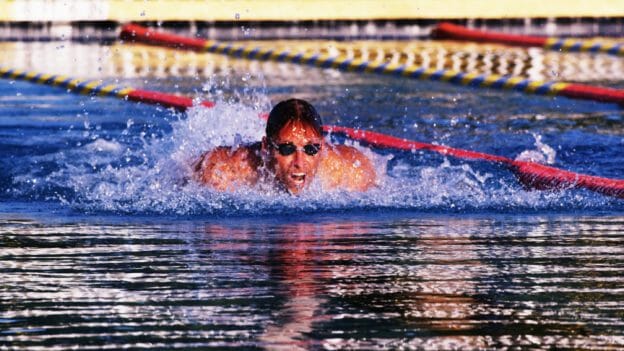The Art of Breathing Part I – Swim Race
Breathing while swimming seems like a natural thing to do. After all, we do it all the time without even thinking about it and, if we stop doing it, we cannot survive for more than about 7 minutes. Yet, while swimming, breathing is not that simple. The questions ‘How often do we breathe?’ ‘Where do we breathe?’ or even ‘How do we breathe?’ are legitimate ones. The answers are not that obvious, either.
Breathing in swimming freestyle or butterfly can be problematic. It can slow the stroke rate, if one takes too long to get the breath. It can lead to an increase in frontal drag, if the breath causes an alteration in the pulling motion of the arm under water, or if the head lifts too much for the breath. Yet, in any race lasting longer than about 20 seconds, the delivery of oxygen to the muscles, in order to provide an important source of energy, is vital to our ability to sustain speed. In other words, we have to breathe to keep our pace.
The fastest way to swim fly and free is without breathing. Unfortunately, in any race event over a 50 sprint, not breathing enough leads to a catastrophic dependence on anaerobic sources of energy, which leads quickly to a lowering of the body’s pH (H+ ions). Once the body begins to become acidic, the muscles cease to recover or function at the same rate. In swimming vernacular, we ‘die’ in our races.
Perhaps the fastest way to increase the body’s pH, to restore neutrality, is by breathing. The faster the respiratory rate, the more CO2 we blow off in order to increase our body’s pH. Frequent breathing during intense exercise not only helps to maintain a neutral pH, but it also helps prevent the acidosis to begin with by delivering more oxygen to the muscles. Having a pipeline flow of oxygen delivered to the muscles engaged in the activity is essential to high performance swimming. Increasing the stroke volume of the heart, increasing the numbers of red blood cells, improving the transport systems for delivering oxygen to the muscle cells, increasing the numbers of mitochondria in the muscle cells available to convert glucose into ATP (Adenosine triphosphate, the fuel for our muscles), and increasing the number and type of muscle fibers available for contraction are all important parts of the physiological and anatomical improvements we seek from training. Yet, even if we develop those systems, none of them are optimized if we don’t have a nice flow of oxygen arriving at the alveoli of our lungs, ready to be delivered to the muscle.
After the first 20 seconds or so of our race, when we have used up the most readily available and stored sources of high-energy phosphate (Creatine phosphate), the two systems of producing ATP on an ongoing basis are the aerobic (with oxygen) and the anaerobic (without oxygen) systems. The two systems are needed and work simultaneously during intense exercise to produce the kind of power required to swim very fast. While the aerobic system produces more ATP per molecule of glucose than the anaerobic system (approximately 36 moles of ATP vs 2 moles of ATP), the anaerobic system produces ATP faster than the aerobic system. In this respect, they each may have their advantage, yet only the anaerobic system will lower our body’s pH, leading to a dysfunction of muscular contraction. The more we can utilize our aerobic system of producing ATP, the longer we can sustain our power.
If you compare the respiratory rates of swimmers racing with competing athletes from other sports, like running or cycling, where they can breathe at will, the rates of swimmers are usually slower. At maximum effort on land, the respiratory rate of an athlete is typically 50-60 breaths per minute. Rarely is a swimmer breathing that often, either in a race or in practice. One can make the argument that swimmers train hypoxically most of the time, which means that by under delivering oxygen to the lungs, swimmers are developing all of the other body’s mechanisms to deliver oxygen more efficiently to our muscles and to manage lactate production. By training at altitude, where even less oxygen gets delivered to the muscles, one can build all of those mechanisms even better and faster. That is a good thing. But when it comes to racing, other than in the 50 sprints, do we want to race hypoxically? I think not. I can still recall the pain of swimming the 400 IM at the Olympic Games of Mexico City (7,000 feet) in a time about 10 seconds slower than I would have swum at sea level. At altitude, we may not have the choice of getting as much as oxygen as we need, but at sea level, it makes less sense to deprive ourselves of getting that oxygen. That means swimmers should be breathing more, not less.
Next time, we will discuss the how and where of breathing in freestyle and fly.
Yours in swimming,
Gary Sr.

